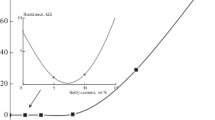Abstract
The sensor properties of In2O3 · SnO2 polycrystalline films having different compositions were studied in the detection of 2% hydrogen in air over the temperature range 330–530°C. Films containing 19% In2O3 were most sensitive to hydrogen. The temperature dependence of the sensitivity of sensors passed a maximum, the position of which depended on the composition of the film. The temperature at which sensor sensitivity was maximum decreased as the content of indium oxide increased. This temperature was 485°C for the SnO2 film and 425°C for the In2O3 film. The response and relaxation times of sensors also decreased as the amount of In2O3 in the composite metal oxide film increased. Possible mechanisms of the sensor sensitivity of the films are discussed.
Similar content being viewed by others
References
G.-J. Li, X.-H. Zhang, and S. Kawi, Sens. Actuators, B 60, 64 (1999).
G. Sakai, N. S. Baik, N. Miura, and N. Yamazoe, Sens. Actuators, B 77, 116 (2001).
N. Yamazoe and K. Shimanoe, Sens. Actuators, B 128(2), 566 (2008).
N. S. Baik, G. Sakai, K. Shimanoe, et al., Sens. Actuators, B 65, 97 (2000).
N. Yamazoe, G. Sakai, and N. Miura, Sens. Actuators, B 77, 116 (2001).
Yu-De Wang, C.-L. Ma, X.-H. Wu, et al., Sens. Actuators, B 85, 270 (2002).
Z. Zhan, D. Jiang, and J. Xu, Sens. Actuators, B 90, 250 (2005).
Gh. Korotcenkov, V. Brinzari, J. R. Stetter, et al., Sens. Actuators, B 128, 51 (2007).
S. Shukla, S. Seal, L. Ludwig, and C. Parish, Sens. Actuators, B 97, 256 (2004).
C. Aifan, H. Xiaodong, T. Zhangfa, et al., Sens. Actuators, B 115, 316 (2006).
K. S. Yoo, S. H. Park, and J. H. Kang, Sens. Actuators, B 108, 159 (2005).
D. Kohl, Sens. Actuators, B 18, 71 (1989).
N. Yamazoe and K. Shimanoe, Sens. Actuators, B 128, 566 (2008).
G. Sakai, N. Matsunaga, K. Shimanoe, and N. Yamazoe, Sens. Actuators, B 80, 125 (2001).
A. Helwig, G. Muller, G. Sberveglieri, and G. Faglia, Sens. Actuators, B 126, 174 (2007).
S. Ahlers, G. Muller, and T. Doll, Sens. Actuators, B 107, 587 (2005).
V. F. Gromov, G. N. Gerasimov, T. V. Belysheva, and L. I. Trakhtenberg, Ross. Khim. Zh. 52, 80 (2008).
D. F. Cox, T. B. Fryberger, and St. Semancik, Phys. Rev. B 38, 2072 (1988).
W. Göpel, G. Rocker, and R. Feierabend, Phys. Rev. B 28, 3427 (1983).
F. R. Sensato, O. T. Filho, E. Longo, et al., J. Mol. Struct. 541, 69 (2001).
I. Tanaka, M. Mizuno, and H. Adachi, Phys. Rev. B 56, 3536 (1997).
H. Gleiter, J. Weissmuller, O. Wollersheim, and R. Wurschum, Acta Mater. 49, 737 (2001).
T. V. Belysheva, G. N. Gerasimov, V. F. Gromov, et al., Zh. Fiz. Khim. (in press).
A. L. Efros, Physics and Geometry of Disorder. Percolation Theory (Nauka, Moscow, 1982; Mir, Moscow, 1986).
Author information
Authors and Affiliations
Corresponding author
Additional information
Original Russian Text © T.V. Belysheva, E.Yu. Spiridonova, V.F. Gromov, G.N. Gerasimov, L.I. Trakhtenberg, 2010, published in Zhurnal Fizicheskoi Khimii, 2010, Vol. 84, No. 12, pp. 2312–2318.
Rights and permissions
About this article
Cite this article
Belysheva, T.V., Spiridonova, E.Y., Gromov, V.F. et al. The sensor properties of SnO2 · In2O3 nanocomposite oxides in the detection of hydrogen in air. Russ. J. Phys. Chem. 84, 2116–2121 (2010). https://doi.org/10.1134/S0036024410120198
Received:
Published:
Issue Date:
DOI: https://doi.org/10.1134/S0036024410120198



